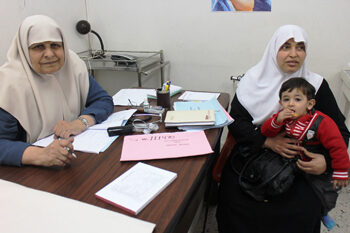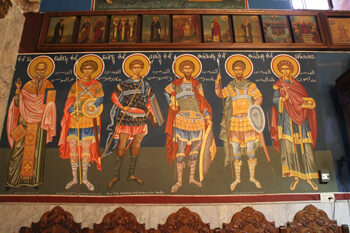ABM Archive Website
THIS WEBSITE CONTAINS ARCHIVE MATERIALS FOR HISTORICAL REFERENCE ONLY
For up-to-date information, including our latest appeals, news, and resources, please visit our current website.
Holy Week in Gaza
 |
| Entrance to Al Ahli Arab Hospital. © ABM/Julianne Stewart 2013 |
I have come to spend Holy Week and the triduum in the Holy Land, or as Bishop Suheil Dawani of the Episcopal Diocese of Jerusalem prefers to call it, ‘the land of the Holy One’. My main purpose is to meet with diocesan staff to discuss diocesan projects that the diocese would like ABM to fund, or contribute towards. One of these is the Al Ahli Arab hospital in Gaza.
The taxi from Jerusalem to Gaza drops me at the Eretz checkpoint at about 10am on a sunny spring morning, the Wednesday of Holy Week. I tentatively make my way to the booth when I hear my name called by the Israeli checkpoint official. He is very young, and seems embarrassed to ask me, ‘Are you carrying a weapon?’ I smile and shake my head. ‘Please go to the passport control.’ Directions are somewhat ambiguous for the first-timer, and the young official points helpfully to one of several doors in the distance. I go inside. A handful of Palestinians are waiting in a short queue. I join them. I am worried I will be asked about the radio-controlled microphone I have brought with me to film interviews at the Al Ahli — the only Christian hospital in Gaza. But nobody looks in my bags. A few bland questions about why I am going to Gaza is all they seem interested in asking. ‘To visit my friends at the church hospital’, is my brief answer. ‘May I stamp your passport?’ ‘Of course’, I say, without thinking. Then, too late, I wonder if such a stamp will impede my travel on this passport anywhere in future.
After a couple of false turns I find myself in ‘the tunnel’, an airy caged footpath that takes travellers both ways through the ‘no man’s land’ that links Gaza to Israel. I look out at my surroundings. Sandhills, a shepherd’s tent, a handful of herdsmen, a small herd of sheep and goats with donkeys and camels. Now I am almost wondering what century I have wandered into, but later it will be explained to me that donkeys and camels are a lot more reliable than vehicles and machinery when stringent rules governing access to electricity and other power sources are applied in this strange prison-like state.
The spring wild flowers are beautiful, yellow and white, against a background of green grass and blue sky. These, together with the sun gently warming my skin, and the peacefully grazing animals, form an almost perfect pastoral scene. But there is also razor wire, an Israeli hot air surveillance balloon hovering above, and the thick concrete security wall in the distance. And I am still in a cage.
After what seems like a kilometre of walking, I get to the other end. The officials are not so interested in why I am here, but want to know if I am bringing in any alcohol.
I am met by ‘my friends at the church hospital’. They are happy that I have come. It means a lot to have visitors from outside. They feel supported, that people outside do care about them. They regale me with stories of hardship, of sudden suspensions of basic goods like electricity and water, of the difficulty of moving in and out of Gaza if you are a local, of the shock of the most recent ‘November War’.
Then there were the specific implications for the hospital of an even larger crisis — the ending of a long contract from the UN refugee agency, UNRWA (United Nations Relief and Works Agency for Palestine Refugees in the Near East), to run the hospital. This is a crisis of the highest order, and will surely impact on the church’s ability to continue their in-patient services, since UNRWA had been providing 90% of the funding. They talk it up for me. Something will be done. The bishop is committed to keeping the hospital going, as a statement of Christian presence in Gaza, a beacon of love and of hope, where almost all the patients are Muslim and are too poor to pay any costs of the service.
There has been a report commissioned to help them plan a way forward. Meanwhile the hospital’s other, community-based, services such as their breast screening clinics, their child trauma work and their child nutrition program, can continue if they can still get donor support. These are currently receiving funding from church-based aid organisations. The diocese (Jerusalem) is also working on income-generation projects such as their three guesthouses, a block of 18 fully-furnished apartments for rent, and a 600 room hotel which they hope will eventually provide enough income to reduce donor dependence in the running of this hospital and of the 30 or so other institutions that the diocese supports. Big dreams, but there is little to lose.
I am whisked off to see the breast screening clinic in action. In a room of forty or so women, a nurse is explaining how to detect early signs of cancer. Women are given a rubber set of breasts to strap on, and are shown how to recognise the healthy ‘breast’ from the diseased one. Once a month men are also brought into the clinic to raise their awareness of the need for early detection for their wives and mothers, and also to learn about the increased incidence of male breast cancer in this part of the world. It looks successful, and the staff report that women are taking their learning on board, and many do discover early signs of breast cancer and are able to come to the clinic for early interventions.
 |
| Dr Heyam Said Saq Alla with a mother and child. © ABM/Julianne Stewart 2013 |
Next I am shown their child nutrition program. Dr Heyam Said Saq Alla supervises the measuring and weighing of a tiny four year old girl with cerebral palsy. She is not only grossly underweight, but has sustained a broken leg when she got in the way of her siblings’ ball game. She is an extreme example, but there are 200 children in each three month intake of the program, about 25 to 30% of whom need continued care to boost their weight and other vital indicators. The main causes of underweight children are poor maternal nutrition and the short space between pregnancies (women are frequently pregnant again one month after giving birth), and the consequent impact on the nutrition of both mother and child. The clinic provides a milk supplement for the child, but in cases of extreme poverty this is often shared amongst other children in the family and the underweight child fails to flourish. The hospital works closely with local community groups who are responsible both for identifying at risk children, and for working with the families to ensure the nutrition program achieves results.
It is this program that ABM may have an opportunity to fund a scaling up, as clearly both the need, and the hospital’s ability to meet the need, are there.
Hospital staff such as Samira, the HR Manager, tell me of the difficulties both of running the hospital and of generally living in Gaza. The Christians on the staff are few, confined to the management and some medical personnel. Samira explains their motivation for staying, against the odds:
“We don’t want people to say, ‘There used to be Christians living in Gaza’. We want them to say, ‘There are Christians living in Gaza’. We don’t just want to be stones (pointing to some archaeological finds from the Byzantine period displayed in the office), we want to be living stones, witnessing to Christ here in Gaza.”
The hospital management want me to see something of the heart and soul of Gaza, the normality of life there. So I am taken to an exhibition, a festival of women’s food and textile crafts. There is a light hearted embarrassment that this is nothing like an exhibition one would find in Jerusalem or Tel Aviv, just a local fair. We go. It is at the beach. Stalls have been set up around a square. The mood is high-spirited. Women show me their handicrafts, offer me samples of their cooking. Against my decision to avoid weight-increasing sweet foods I find myself accepting and heartily enjoying a large piece of sticky baklava. Smiles all round. I buy a packet of lighter sweets to take back to Jerusalem. I am regaled by all manner of women’s handiwork, from traditional embroidery to Bedouin hand painting to unimaginable artistic creations.
I take photos of the women, the crafts, the beach in the sunlight with its camels offering rides along the sand. It looks idyllic. I am told that the sea is not safe to swim in, as 250,000L of untreated human waste is disgorged into it each day. During times of crackdown the Israelis restrict the distance the local fishing fleet can stray from the shore. I decide not to eat the local fish at dinner later that night.
I am taken on a tour of the latest bomb sites. Then to a restaurant for dinner which serves ‘the best pizza in Gaza’. It is delicious, and it feels very normal to be eating outdoors with my newly found colleagues at a local family dining establishment, the full pre-Easter moon rising behind us in a clear, starry sky. As we leave I notice a large mirrored wall in the almost new restaurant has myriad cracks. My mind automatically turns to thoughts of youthful vandals, until my host comments that it was cracked during the ‘November War’.
 |
| A collection of ancient saints. I would compare these with the current day saints who run and work in the hospital. © ABM/Julianne Stewart 2013 |
On my way back to the Erez checkpoint the next day, Khalil, the hospital driver, and Jaleel, the young admin officer, take me to the Greek Orthodox Church of St Pamphilius. It is an ancient below-ground-level portion of a once much larger church dating from the 4th century, and said to have been built by St (Queen) Helena, the mother of Emperor Constantine. Most of the church has now been converted into a mosque. What has been left to the Christians is the old funeral chapel. It is a beautifully kept church, decorated in typical orthodox style. An oasis of beauty and hope amidst the drabness and poverty that characterises much of Gaza. After showing me around, Jaleel and Khalil, who are both cantors at the church, proceed to sing, with clear, beautiful, almost haunting voices, part of the church liturgy. This living link to an ancient, almost forgotten, religion sends a chill down my spine and brings tears to my eyes.
I am driven to the checkpoint. The formalities are brief. As I walk through the caged walkway back into Israel I am overtaken by two young men wearing UN Food Program t-shirts. They chat gaily in Italian. For a moment I reflect on the ease of their (and my) movements in and out of Gaza, while the people I have visited stay steadfastly behind. The living stones of a tiny and ancient Christian presence among a people with nothing but a dogged hope that justice will eventually prevail.
Dr Julianne Stewart
Programs Director
March 2013
‹ Back


